One of the main problems Clinton says that he sees with horse owners as he travels around the country giving clinics is that people just don’t canter their horses enough. There are always a few who simply refuse to canter, he tells us — and more than that who do the Cruising Lesson at the canter with white knuckles, clenched teeth and tension throughout their body that tells the horse, “I hate this as much as you do.”
Most Comfortable Gait to Ride
That’s not the way it’s supposed to be. Cantering, to someone who does a lot of it, is as natural as breathing. It is the horse’s most comfortable gait to ride, which makes it the nicest part of riding for many. However, to get to the point of being able to go out for a nice slow, relaxed lope — or to do any of Clinton’s riding exercises at the canter, it does take practice — for the rider and for the horse. “For a horse to get good at cantering, you have to put plenty of miles under his feet,” Clinton is fond of saying. To do that, someone has to be riding him, and most likely, if it’s your horse, that someone is you.
Clinton says that every time he repeats this advice to a new audience, the people look at him and nod their heads and seem to understand. Then, when it comes time to canter a house, the excuses start to flow. Many are reluctant, and most often there is a handful that flat out won’t canter their horses. So what’s the real problem, he started to wonder every time the white knuckles appeared at his latest clinic stop. So he started asking questions.
“It’s fear, plain and simple, the more honest ones tell me,” Clinton says. “So that got me to wondering, ‘how can I help people get past that fear and just ride through it?’ I’ve seen plenty of people do it in my clinics and there is no way to describe the look of complete exhilaration on their faces. In fact, seeing people make this kind of breakthrough is one of the most gratifying parts of my job.”
For many people, the way to get past their fear of cantering is just to somehow find the courage and, as the Nike ads used to say, “Just Do It.” Clinton notes that there are always a few people who just need a nudge, a command of “just canter that horse, woman, spank that donkey and get his feet moving,” yelled from across a crowded arena with spectators watching. Very often, Clinton observes with a smile, this works quite well. “That’s why I keep doing it,” he adds. “It also generally makes people laugh and lightens the mood, but that’s just a bonus.”
Then there are others who come over to him and say, “Clinton, I just can’t do it. I know you’re right and I need to get over this, but I am afraid to canter my horse.”
“What do you think is going to happen?” Clinton usually asks, trying to get to the cause of this fear.
“I don’t know,” is usually the answer. Again, he says, the more honest ones say, “I’m afraid my horse will do something silly and I’ll fall off.”
So then Clinton usually has one of his Professional Clinicians canter the horse for them to make sure that the horse is safe enough for them to canter on. Sometimes a horse that isn’t used to cantering very much may not like it at first and may offer some resistance. This resistance can come in many forms, depending on the horse’s temperament and personality, from simple refusal to kicking up, crow hopping or outright bucking.
For anyone who has ever asked a horse to canter and been met with these behaviors — and especially if they were bucked off during one of these episodes — it may be very hard to make themselves ask their horse to canter again. For some of these people, seeing their horse cantering just fine with someone else on his back is enough to encourage them to try it. Clinton says that’s why he often advises people, “If you’re not comfortable cantering your horse, ask or hire someone to canter him for you. Once you know he’s used to the idea, it will be easier for you to then go and do it yourself.”
But sometimes, it’s not. Sometimes people just can’t get past that fear and “Just Do It.” Sometimes the fear of cantering stops them completely and they just give up, calling themselves “walk-trot people.” Often, this means that their horse gets worse and worse and eventually they become afraid to even walk or trot. Fear of anything, left unchecked, has a tendency to spread to other things. The good news is confidence works the same way.
It is for the sake of these people that Clinton invited Dr. Matt Johnson, a sports psychologist and consultant to the equestrian team at Texas Christian University and other performance athletes, to help us dissect the fear of cantering in order to put fear in its place and people back in the saddle, losing those white knuckles for good.
“It’s not like I’ve never been afraid,” Clinton says. “In fact, the first time I ever experienced cantering it scared me to death. I was on my grandparents’ farm and my grandfather was leading the horse.
Another personal experience Clinton remembers about dealing with fear was back in Australia when a mare he was attempting to train got her bluff in on him so badly, and he was so afraid, he nearly quit horses for good. [More about that later.] And Clinton will be the first to tell you, when you’re working with a 1,000-pound animal, healthy fear is the thing that keeps you safe, and that is a good thing. It’s when fear gets bigger than it needs to be, gets in the way of your doing what you are capable of doing, and starts to undermine your confidence that we have to stop, take hold of that fear and put it in its place. “That’s just what Dr. Johnson is here to help us do,” Clinton says. “So get a note pad, and let’s get to it!”
The Function of Fear
“Fear is a natural part of being human,” says Dr. Matt Johnson, who is a Certified Sports Psychology Consultant and licensed professional counselor in private practice in Fort Worth, Texas. Johnson frequently works with the equestrian team and many other athletes at TCU on performance-based issues as well as issues of anxiety and fear. “Our job is to separate the productive fear that helps keep us safe from the non-productive fear that hinders our performance.”
Fear, Johnson explains, is a powerful emotion. Because anxiety is related to our perception of our skills and knowledge, fear can distort these perceptions and make everything seem much worse than it actually is.
To help people work through these distortions, Johnson has a process he takes people through that has proven successful at all levels of endeavor. This process requires a pad of paper and a willingness to dig deep, in addition to spending some quality time with your horse.
Why do you ride?
“First I ask people, ‘why do you want to ride — and what do you want to get out of it?’” Johnson says. “Sometimes this gets lost in the fear. I just tell people to jot down whatever comes to them about riding a horse or playing the sport that makes them want to do it. I want them to remember their passion for it in the first place.”
What are your goals?
If fear were not an issue for you, what would you want to do with a horse? Trail ride? Show? Compete? Johnson asks that this next list be of specific goals the person would have — a list of dreams of what they’d like to do with their horse if they could.
After completing this list, rank them in order and go to a quiet place and imagine yourself doing those things. How would it feel? Can you feel that sliding stop and hear the applause and whistles of the crowd at the NRHA Futurity?
Can you feel the motion of that cutting horse under you as he gets after a cow? Can you feel the wind in your face as you race down a fence line in a working cowhorse competition? Can you imagine the feeling you’ll have after finishing a perfect dressage pattern, clearing the water hazard, or winning that showmanship ribbon? Can you imagine yourself riding down a trail on a perfect spring day, camping out with your horse, or swimming your horse in a lake?
What can you do?
In the situation of working with someone who is afraid to canter a horse on a loose rein, Johnson says he would ask them to make a list of what they can do related to the horse, starting from the second they get to the barn or pasture, all the way up to cantering in Clinton’s Cruising Lesson.
“Fear is a natural part of being human. Our job is to separate the productive fear that helps keep us safe from the non-productive fear that hinders our performance,” says Dr. Matt Johnson.
Can you catch the horse?
Can you pet the horse?
Can you lead the horse?
Can you tie the horse?
Can you groom the horse?
Can you saddle and bridle the horse?
Can you do basic pre-ride groundwork with the horse?
Can you get on the horse?
Can you flex the horse?
Can you walk the horse?
Can you do a One Rein Stop at the walk?
Can you trot the horse?
Can you do a One Rein Stop at the trot?
Can you canter a few steps and do a One Rein Stop?
Can you canter on a loose rein in the roundpen?
Can you canter on a loose rein in the arena by yourself?
Can you canter on a loose rein in a clinic setting with 19 other riders doing the same?
How well do you do it?
After each answer, Johnson asks his clients to rate their comfort with each skill from one to ten, with one as “No way, Jose!” and ten being “Piece of cake!”
Johnson says that usually as he goes through this list with people and has them read out their competencies, more often than not they are surprised at how much they do know, how much they are confident with and what a small percentage of the big picture the fearful tasks tend to occupy. “Fear can make a lack of confidence in 20 percent of the competency required to canter a horse feel like 80 percent,” he adds. “It’s only by breaking it down in this way that we can put fear into its proper perspective.”
The next part of this step, Johnson explains, is to look at any number on our rating scale and ask ourselves why that’s the right number — and what it would take to move to the next number.
While that’s all well and good, you might say, it doesn’t help much when it’s time to step up on that horse.
So the next question Johnson typically asks is:
What Are You Afraid of?
“It’s important to talk about exactly what you are afraid will happen,” Johnson says, “starting with the biggest fear and working down to the smaller ones.” Johnson asks his clients to write down the fear in as much detail as possible. Next, write down everything you know how to do to respond to that fear.
Using specific exercises and strategies that are key to Clinton’s method as an answer guide, write down after each specific fear which skill you’d need to best address it. For example, if you’re afraid your horse will start bucking when you ask him to canter, what would Clinton tell you to do? What is your ability from 1 to 10 to do that? What are the cues from the horse you would look for to tell you he is about to buck?
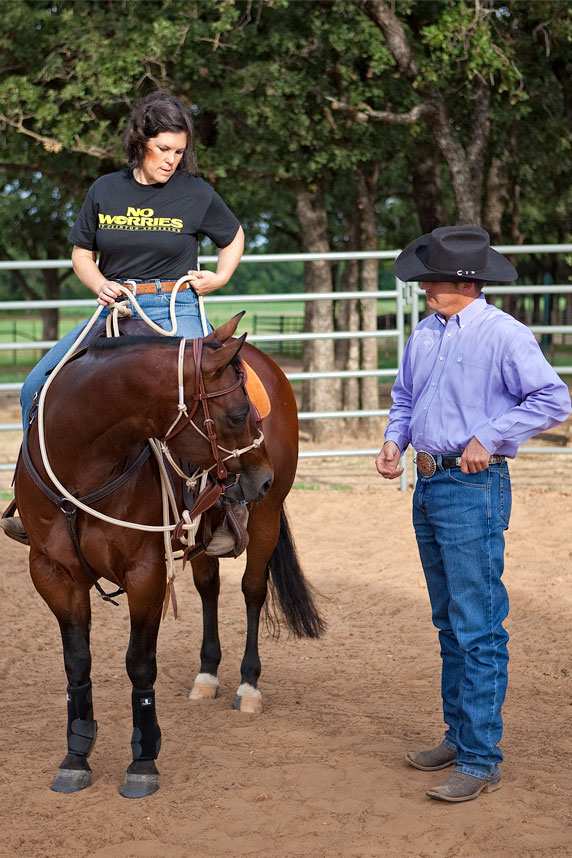 Visualization becomes more powerful with the more senses you can engage. So instead of just sitting at home imagining herself doing a One Rein Stop, our rider is doing this visualization while actually sitting on the horse.
Visualization becomes more powerful with the more senses you can engage. So instead of just sitting at home imagining herself doing a One Rein Stop, our rider is doing this visualization while actually sitting on the horse.
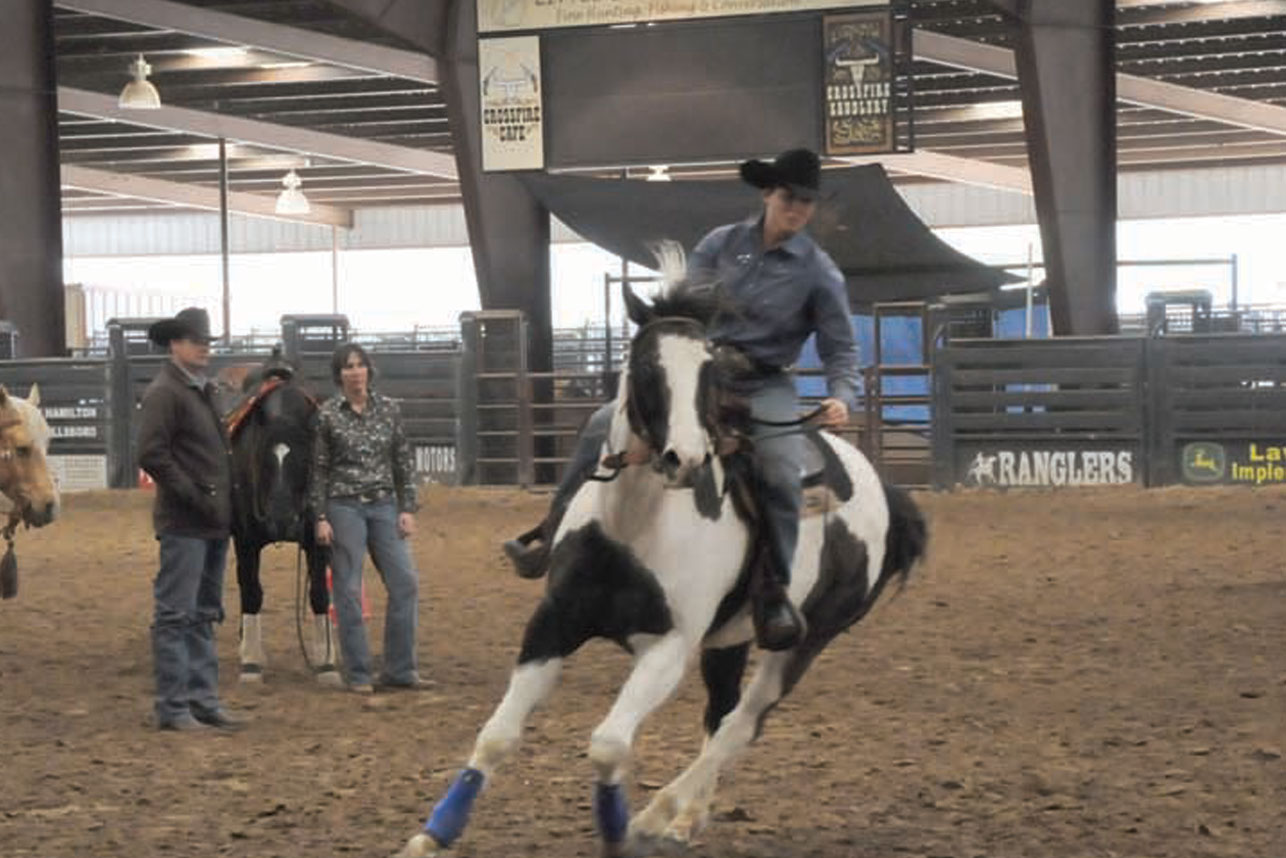 Actually seeing someone else doing with ease what you are afraid to do—preferably a model of your same gender — plants that image in your subconscious.
Actually seeing someone else doing with ease what you are afraid to do—preferably a model of your same gender — plants that image in your subconscious.
Visualize Success — with all your senses
This is a powerful strategy, says Johnson. To do this you not only mentally see yourself responding appropriately to your horse that’s kicking up or starting to buck, but you imagine hearing the sound of his hoofbeats, the smell of the horse, how that horse feels underneath you as the dreaded hump rises in his back. Then, you imagine that hump disappearing as you spank him to get his feet moving forward, turn him into the fence, bend him in a tight circle, or do a One Rein Stop. “The more you can use your imagination to engage all your senses,” he adds, “the more powerful your visualization will be and the more it will take root in your brain.” Johnson says science confirms that our brains and subconscious cannot tell the difference between an actual event and one vividly imagined. So tune up your senses and see how real your imagination can make it.
Johnson says another way to visualize success is to find a model that is as much like you as possible and watch that person canter a horse, solve problems, and negotiate any difficulties with ease. Although this is no substitute for your own visualizations of yourself doing these things, it does augment that image, Johnson adds.
Another issue around visualization, Johnson says, is controllability of these images — that is, how well you can picture yourself doing these things. If you can’t do it at all, it is important to move back down the list of competencies you made in step one and find something you can visualize yourself doing well.
Small, attainable Steps
This is where the process becomes very individual, Johnson says. Each person must determine for themselves exactly what their starting point is and what the steps are from that place to the place where they’d like to be.
Once you find your starting point — that place where your confidence starts to wear thin and your fear begins to gain momentum –– go back to Clinton’s method and find the exercises in that situation that will help you move your competency up the scale toward 10.
Clinton’s Eight Steps to Cantering with Confidence
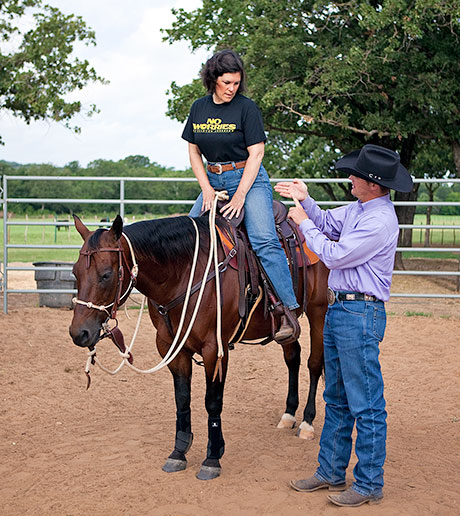
1. Make sure your stirrups are the right length. The way to know that you’ve got your stirrups right is if you can put four fingers’ width between you and the seat of the saddle when you stand up in the stirrups, as this picture indicates. With stirrups that are too long, you can’t get your heels down very well, and if they’re too short, you can’t sit back well. Both of these things are key to good balance when cantering.
When your stirrups are the right length, you should be able to get four fingers’ width between you and the seat of the saddle when you stand up in the stirrups.
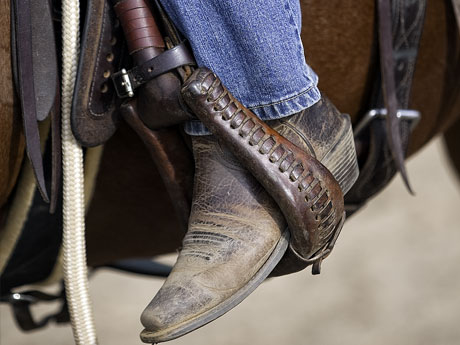 2a. One sign of an unbalanced rider is improper foot position. When your toe is down like this, your whole body is pitched forward and off balance.
2a. One sign of an unbalanced rider is improper foot position. When your toe is down like this, your whole body is pitched forward and off balance.
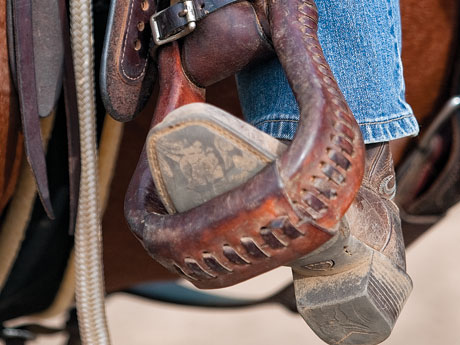 2b. When you learn to keep your heels down, it really helps keep your body in position to sit back in the saddle — and gives you the leverage you need to post from the balls of your feet. Practice this at home on a step; strengthening and stretching that Achilles tendon will help make keeping your heels down easier to do once you’re in the saddle.
2b. When you learn to keep your heels down, it really helps keep your body in position to sit back in the saddle — and gives you the leverage you need to post from the balls of your feet. Practice this at home on a step; strengthening and stretching that Achilles tendon will help make keeping your heels down easier to do once you’re in the saddle.
3. Find a horse that will build your confidence rather than wreck it. How do you learn to ride a bike? You ride it, and ride it, and ride it. But you don’t just hop on and ride — first you get yourself some training wheels. Finding a horse that already knows how to lope gives you those cantering training wheels.
4. Riding on a loose rein is another big secret because it teaches you to ride the horse without using the reins or your legs for balance.
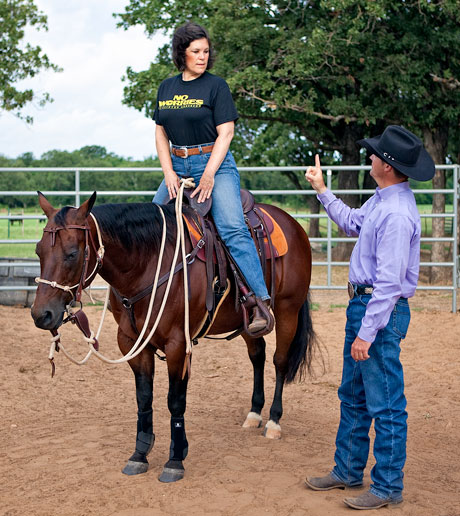
5. Posting a lot is another big secret because it trains your body to move in rhythm with the horse. People make posting sound like a complicated thing, but it’s really not that hard. Just push your body up using the balls of your feet, saying “Up!” and then sit down, saying “Down.” Pretty soon your up and down motion will find its way into the rhythm of the horse. You’ll know this when you feel it because it will suddenly become much easier. Post as much as you can for two or three weeks — or until moving in rhythm with him is automatic.
Posting to the trot is a great way to improve your balance, build your confidence, and train your body to get in rhythm with the horse. Simply push up from the balls of your feet, saying “Up!” and then sit down, saying “Down.” After a while, you will naturally find the right rhythm.
6. Practice your One Rein Stops at the walk and trot. When you’re ready to start One Rein Stops at the canter, ask the horse to lope, but only let him go two strides before shutting him down. This teaches you that just because the horse is going to break into a canter, that doesn’t mean you have to go somewhere. It also reminds the horse that just because he starts to canter, he still needs to check in with his rider and not just leave town.
7. If you’re still unsure about your horse, have someone else lope him for a few days and get the fresh off of him. That’s what we do at clinics and that’s what we advise everyone to do at home. With an experienced rider to get on and canter him for the first few times, you can make sure everything goes right and that all the spookiness and jumpiness is out of him before you get on. Also make sure the horse has not been overfed, cooped up or is otherwise bursting at the seams with excess energy
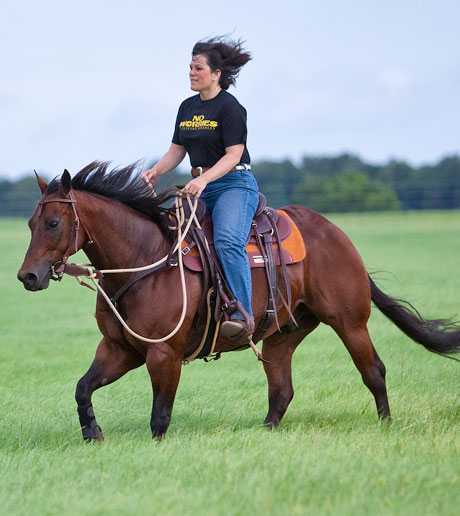
8. After that, just get on that horse and lope. Just lope and lope and lope. There is really no substitute for putting your butt in the saddle and riding as often as you can for as long as you can to put some steady miles under your feet.
“The most important thing I do to help people conquer the fear and anxiety that are getting in the way of their performance is to help them see the strengths, skills and resources they already have, and then make a plan that will lead them back to their goals and their passion.”
“If you’re afraid to do a particular exercise, such as the Cruising Lesson at a Canter,” Clinton advises, “Do it first at a walk or trot. If balance is the issue that has you most concerned, get good at doing this exercise at a trot. Remember: Posting is the secret to building balance, so trot and post until you are sick to death of trotting. Take cantering completely off the table for now; just trot and post until you feel balanced moving with that horse. Don’t guess or think where he’s going to go; make yourself feel his movement shifting and then follow that movement with your own body. Trot until you can put a 10 next to “Cruising Lesson at a Trot” on your rating list.
Find yourself a “safe horse”
One of the biggest problems Clinton sees is people trying to learn to canter on a horse that doesn’t know how to canter either. Whether or not that horse is going to do something silly is really beside the point, he says. This leads up to one of his favorite adages, “Green horse plus green rider equals a recipe for disaster!” Although this is generally meant for beginners riding young horses, it also applies to learning anything on a horse that is learning it, too. “Horses teach people, then people teach horses,” is another favorite saying that applies here.
If you’re really nervous about cantering, even on your “safe-horse,” try it first on a lunge line. English instructors have been doing this for years, Clinton says, and the reason is that it helps build the rider’s confidence by knowing exactly where that horse is going to go — and that there is someone who has control of that horse if something starts to go wrong.
Next, after practicing your One Rein Stops in the roundpen at the walk and trot, get comfortable with posting while doing the Cruising Lesson at the trot. Once this feels comfortable, and this may happen over a period of days or weeks, canter your horse for just a few steps and then do a One Rein Stop. Do this until you are comfortable with this feeling, then start stretching out the distance between stops until you find yourself cantering around the roundpen on a loose rein. Once you get comfortable with cantering on a loose rein in the roundpen — and this can be anywhere from a few rides to a few weeks — you’re ready to repeat this entire process in the arena, beginning with all three gaits on a lunge line. Once you’re ready to unclip, start with your One Rein Stops at a trot. Without the safety net of the roundpen, One Rein Stops at a canter can be a little bit scary to some people at first. However, by now you have built your confidence in this process, which, even though it takes a little longer to spiral down to a stop at faster speeds, it’s exactly the same.
Be sure to spend plenty of time loping that “safe-horse.” Lope him until you feel completely relaxed and confident and you can move all over him. Reach back and pat him on the butt, lean over and rub his neck, move all around like you’ve been drinking. This is the kind of relaxed balanced confidence that will give you a 10 on that “Cantering a ‘Safe-Horse’” item on your list and equip you to go back to the horse that doesn’t know how to canter and teach him.
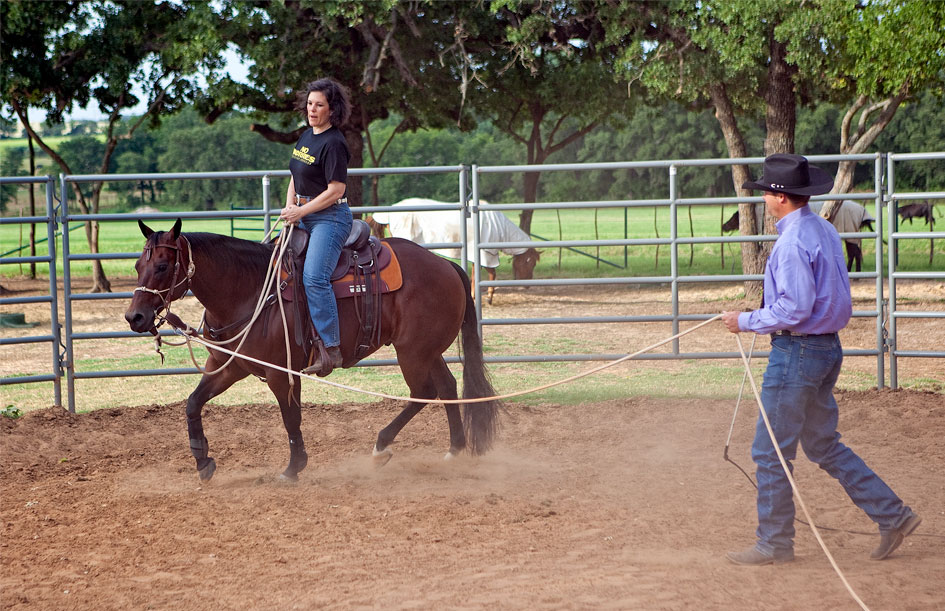 Starting on the lunge line is a good starting point for many riders because it offers the assurance that someone has control of that horse. Here, our rider begins at the trot…
Starting on the lunge line is a good starting point for many riders because it offers the assurance that someone has control of that horse. Here, our rider begins at the trot…
 …negotiates a turn, practicing sitting back, relaxing, and moving with the horse…
…negotiates a turn, practicing sitting back, relaxing, and moving with the horse…
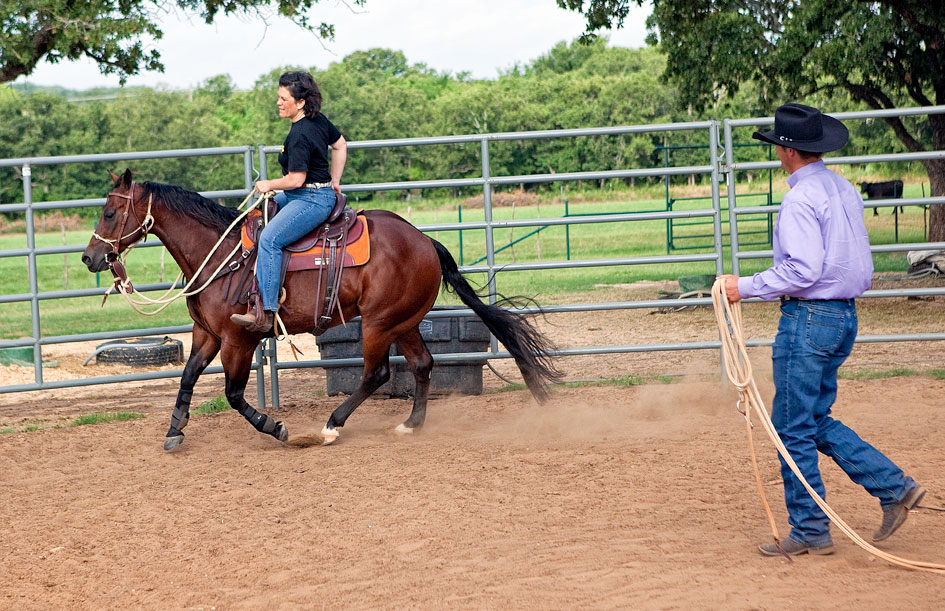 …and finally canters on his own.
…and finally canters on his own.
Still afraid to canter your own horse?
What if you do just fine with your “training wheel” horse, but still get a knot in your stomach at the thought of trying the same exercises on your own horse? “If you have your own competency as a rider verified, but cantering your own horse is still scaring you because of his past bad behavior,” Johnson says, “you have to ask yourself how important it is that you continue to ride that horse.” Johnson adds that this is not so much advice to get rid of a horse that scares you but rather to re-examine your goals and motivations to canter that horse — to go back, as it were, to the beginning of your relationship with that horse and asses why you want to ride that horse, what your goals with that horse are and where you are in that process.
“If you discover that riding this particular horse is still important to you,” he says, “then by all means move forward with the process of determining exactly where you are and building your steps to conquering that fear from there.”
Knowledge is Power, and Power is Action
Johnson says that by facing, dissecting and then moving forward into your fear of cantering, you empower yourself to make that fear a thing of the past. And, he adds, you may find that the benefits to working through this process extend far beyond the realm of cantering your horse. “Our fears are clues to learning more about ourselves,” he says. “Fear is not just something in our way, but rather an opportunity to transfer the power a particular fear has over you to empowering yourself to change.”
Like any skill, Johnson says, the more you practice doing these steps to get past the fear, the easier it becomes — and the better you get at it. Although coaching is helpful, it all comes down to the individual’s ability to identify their goals, strengths, challenges, visualize their success, and follow a step-by-step plan. “The most important thing I do to help people conquer fear and anxiety that is getting in the way of performance,” Johnson says, “is to help them see the strengths and skills and resources they already have, and make a plan that will lead them back to their goals and their passion.”
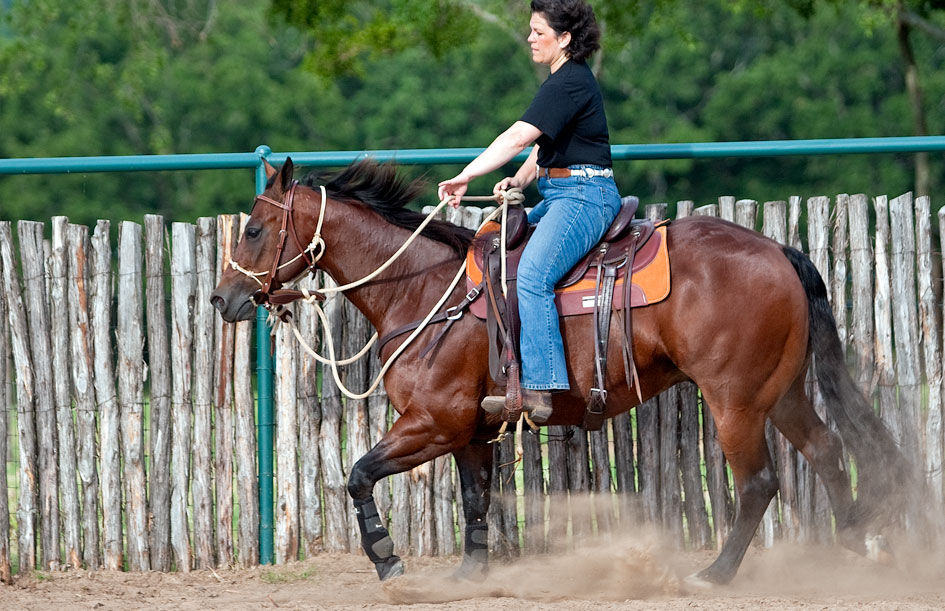 A One Rein Stop at the canter is a bit scarier for some people because you’re going a little faster and it takes a little longer for the horse to spiral down to a complete stop. The process, however, is still the same: first slide your hand down the rein…
A One Rein Stop at the canter is a bit scarier for some people because you’re going a little faster and it takes a little longer for the horse to spiral down to a complete stop. The process, however, is still the same: first slide your hand down the rein…
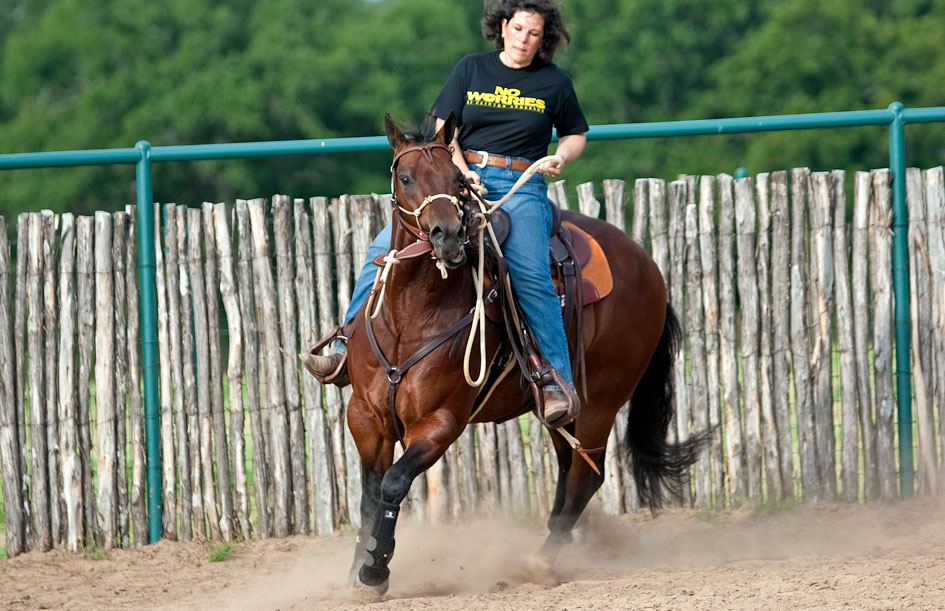 …let the horse spiral down to a stop, keeping the pressure steady and pulling back toward your hip…
…let the horse spiral down to a stop, keeping the pressure steady and pulling back toward your hip…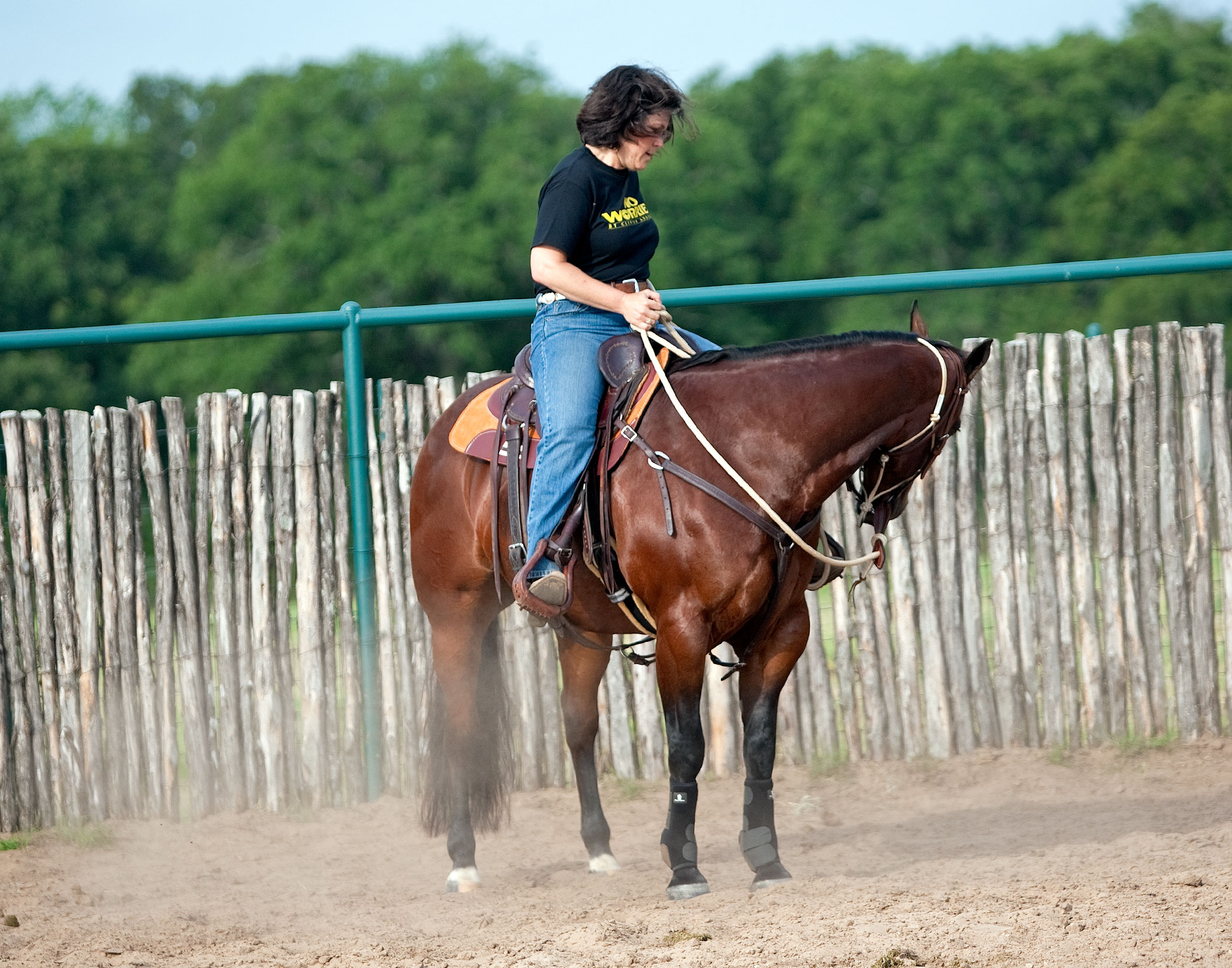 …and when the horse comes to a complete stop and touches his nose to your boot or stirrup, release.
…and when the horse comes to a complete stop and touches his nose to your boot or stirrup, release.
Troubleshooting Tip:
Remember to squeeze, cluck and spank to keep your horse cantering when he wants to stop.
When you start to do the Cruising Lesson at the canter and your horse drops down to a trot, squeeze first with your legs. If he doesn’t pick his speed back up, while still squeezing, cluck. If he still doesn’t pick up his speed, while still squeezing and clucking, spank from side to side with the end of your mecate. Do this gently at first, in front of your legs, just to warn him. For a lot of horses this is all it takes. If a gentle spank isn’t enough, gradually turn up the heat. When you can cruise your horse at a canter for five minutes without having to correct him at all, he is ready to move on to doing other exercises at the canter
If your horse’s feet get sticky and he doesn’t want to canter, get him moving by spanking from side to side with the end of your mecate as I’m doing here. This keeps his mind and his momentum moving forward. Remember: If he wants to break down to a trot, let him, but then immediately squeeze, cluck, and spank if you have to, to get him cantering again.
Does your horse act up when you ask for a canter?
If your horse kicks up or crow hops when you ask him to canter or when you spank him with your mecate and you feel it is more than you can ride through, do a One Rein Stop, disengage his hindquarters, get off him and get his feet really moving from the ground. Do Lunging for Respect Stage Two with lots of changes of direction; the more changes of direction you do, the more respectful the horse will become and the more he will start to use the thinking side of his brain. That’s why I love to ride in my mecate reins; it’s like having a built-in halter. I can get off my horse and immediately start moving his feet. After really getting your horse moving on the ground, let him rest and rub him as if nothing happened, then get back on and start the process over again. It usually doesn’t take more than one or two times of doing this before he realizes two things. First, he might as well go ahead and canter when you squeeze because it’s just going to get worse for him after that if he doesn’t. Second, kicking up and crow hopping to register his displeasure isn’t worth the extra work he has to do on the ground when you get off. Pretty soon he’s going to want to make sure you stay on his back to keep that from happening — and cantering a little longer is really the most comfortable solution for him. From there you’re home free. Just gradually add time to every ride, put those miles under your feet, and before you know it, those white knuckles will be gone for good.
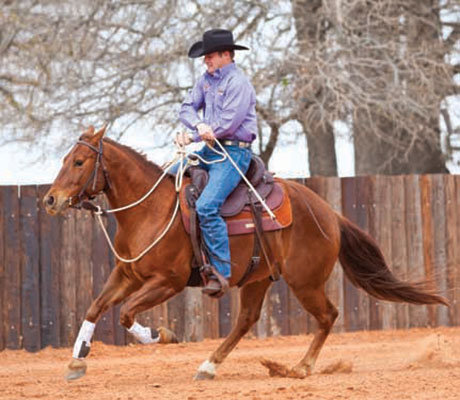 If your horse’s feet get sticky and he doesn’t want to canter, get him moving by spanking from side to side with the end of your mecate as I’m doing here. This keeps his mind and his momentum moving forward. Remember: If he wants to break down to a trot, let him, but then immediately squeeze, cluck, and spank if you have to, to get him cantering again.
If your horse’s feet get sticky and he doesn’t want to canter, get him moving by spanking from side to side with the end of your mecate as I’m doing here. This keeps his mind and his momentum moving forward. Remember: If he wants to break down to a trot, let him, but then immediately squeeze, cluck, and spank if you have to, to get him cantering again.
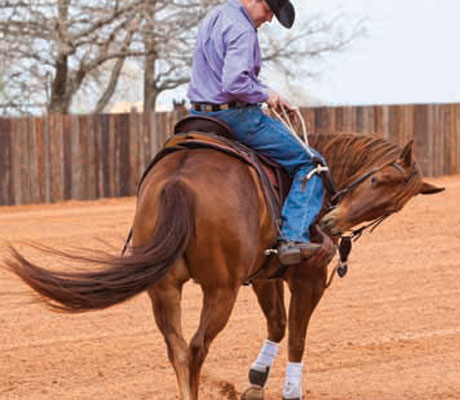 If your horse wants to kick up, crow hop, or buck when you ask him to canter and you’re not comfortable spanking him to get his feet moving forward, just do a One Rein Stop, disengage his hindquarters as I’m doing here, get off, and get right to work moving his feet from the ground.
If your horse wants to kick up, crow hop, or buck when you ask him to canter and you’re not comfortable spanking him to get his feet moving forward, just do a One Rein Stop, disengage his hindquarters as I’m doing here, get off, and get right to work moving his feet from the ground.
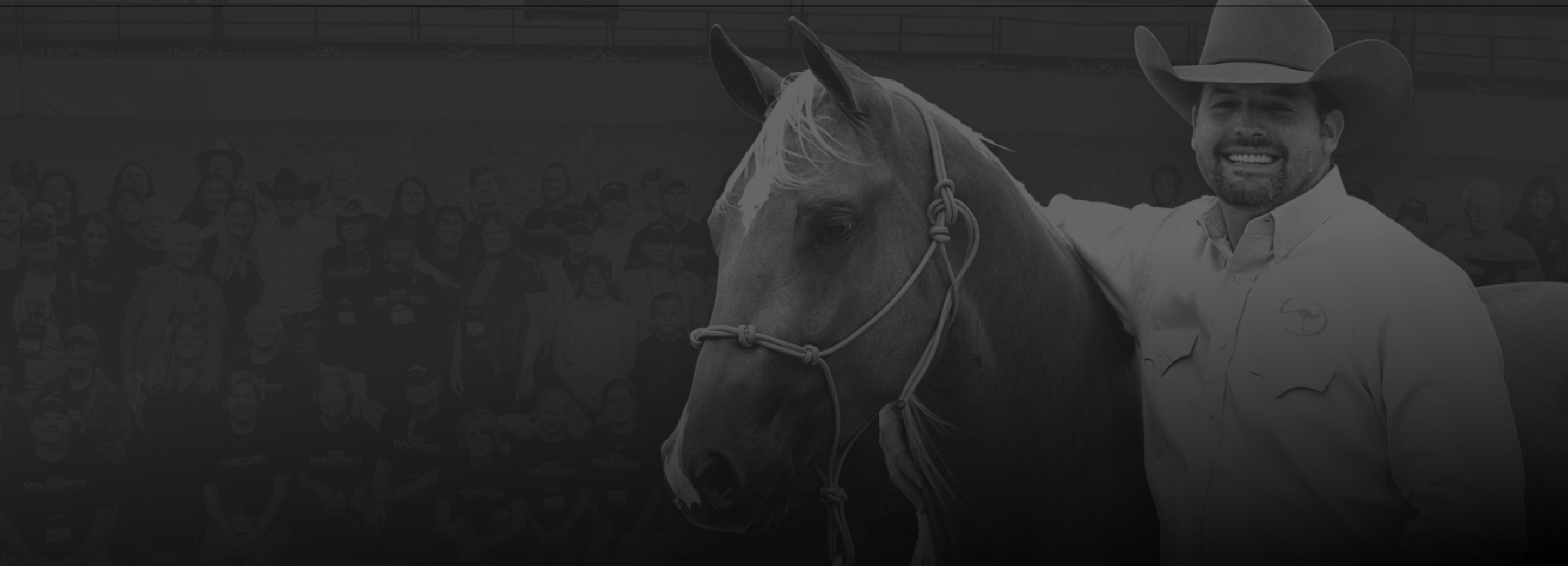
Want To Learn More? SIGN UP FOR OUR LOYALTY PROGRAM
Master your horsemanship training through Clinton’s step-by-step method videos by joining the No Worries Club today. Becoming a club member ensures you get VIP pricing on all of Clinton’s must-have training tools and resources. Plus, you’ll enjoy all the phenomenal benefits that come with club membership!



